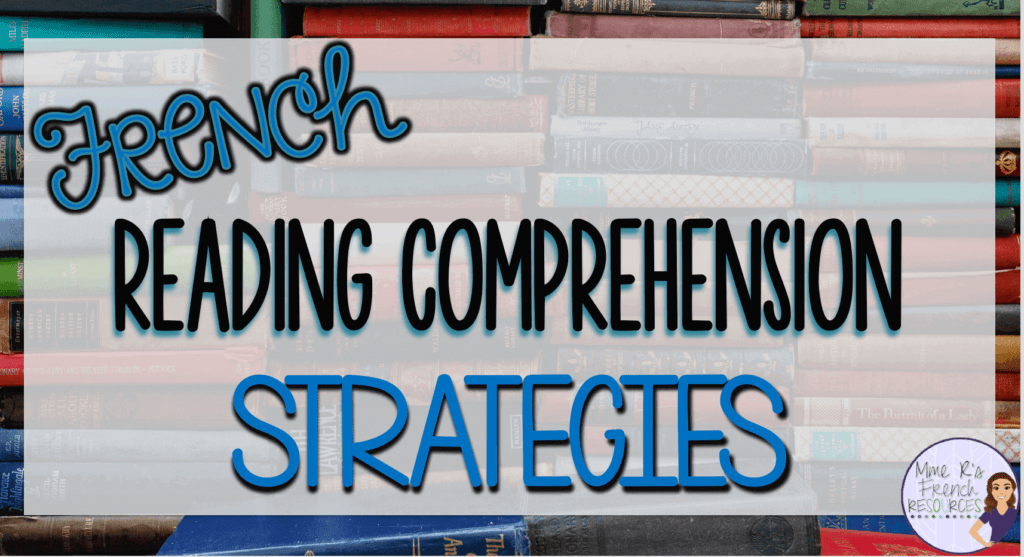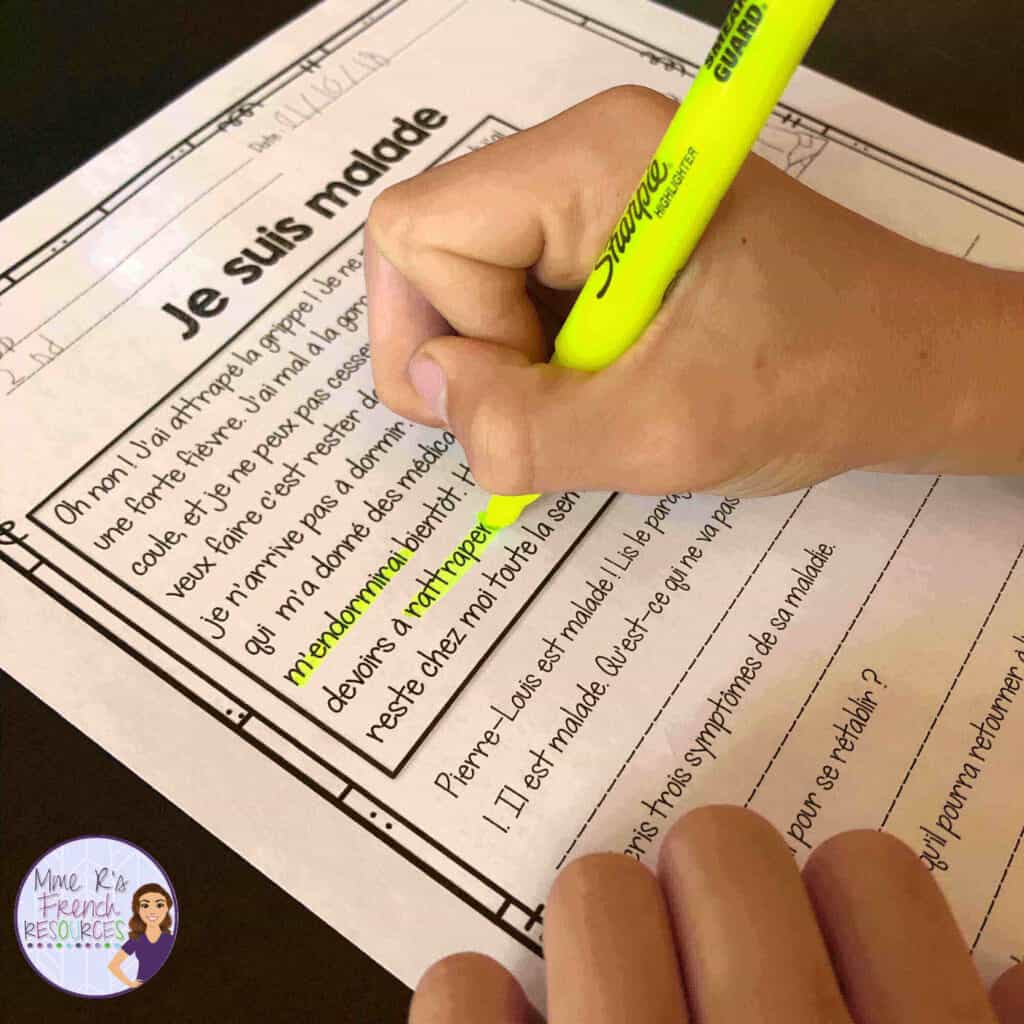
Teaching French reading comprehension doesn’t have to be intimidating, and neither does getting students reading in French. With effective reading strategies, students will gain the confidence and skills to read French texts on their own. Whether I was an FSL teacher or a French immersion teacher, reading comprehension was always a big part of the program. Here are some strategies I’ve used to teach reading comprehension across a variety of levels.
Step 1: Pre-reading
Pre-reading is an important step when teaching French reading comprehension, because students are faced with so any unknowns. Scanning the text and looking at the images help the students begin reading the text with an idea of what will be discussed. Here are a few pre-reading strategies that are helpful when students start reading in French.
- Look at the pictures.
- Look at the title.
- Scan text for familiar words.
- Brainstorm words that relate to the topic. These don’t need to be in the text. This can be done individually or as a class. If you do it as a class, write the list on the board for the students to see as they read.
Step 2: Read the text
When reading in French, if you are working with a short passage, I recommend reading the text three times. Read the text once as a group. Next, the students will read the text a second time on their own. Third, they will reread the text, looking for specific details.
Reading 1 : Read the text out loud as a class.
When trying to improve French reading comprehension, I think reading aloud is so important, because it really helps kids who are auditory learners. They hear the text and see the text, helping them create an image of how the word sounds and looks. In French, this is really important, because many words just don’t sound exactly how they look.
For the first time students are reading in French, students will just read to get the gist of the text. They shouldn’t get caught up on new words. If new words in the text are discovered that fit with the theme of the text, write those words on the board (in a different color, if you have brainstormed words on the board). Make sure all students understand the words. This list should be entirely student-generated, so if they don’t find new words right now, that is fine. They will be looking closely at new vocabulary later.
Reading 2: Students read the text individually.
For the second time reading in French, students read the text again on their own. It’s here that they will try and break down the text and make sure they understand it. While reading, I use the following French reading comprehension strategies to help them get a better understanding of the text.
Use context
At this point, I don’t encourage students to look words up. They will constantly come to words they don’t know when reading in French, just as they do in their native language. They should try to use the context to determine the meaning as much as possible.
Break apart words to familiar parts
An easy way to help students improve their reading in French is to teach them common prefixes and suffixes that can help them learn other words related to the one they know. Students will often learn a word in only one form, but that doesn’t mean they won’t recognize variations of it.
For example, students might have learned the verb danser. From this word, they can determine the nouns danseur and danseuse easily, even if the haven’t formally learned the suffix -eur/-euse.
Beginning students are also usually able to understand the relation between words such as fromage/fromagerie or poisson/poissonnerie. If they don’t immediately see the relationship, you can provide a few examples. From there, most students will easily identify find the relationship between words and will be able to transfer this to other words, such as knowing that a bijouterie is a place where one buys des bijoux.
Understanding common prefixes also helps students, and because many are similar to English, they are really easy to learn. Here are a few common prefixes you can focus on:
- il- / im- / in- / and ir- which provide the opposite of a word (such as patient versus impatient).
- r – / re- / ré before a verb to show the action is being done again
- pré to express the idea of “before”
I usually start with these prefixes, because they are very common and will be familiar to students. You can add more prefixes as students gain proficiency.
Look for key verbs
Students might be reading in French and see a tense they haven’t mastered. It doesn’t really matter if they have formally learned the futur simple in order to read a text. If they recognize a verb (conjugated or in its infinitive form), they can determine the time frame later by looking for markers of time, such as tomorrow, last night, or this weekend.

Highlight words
When reading in French, students should highlight important words that help understand the text, such as adjectives that would help them determine if the author is masculine or feminine. At this point, they can also highlight words they cannot determine from context.
Discuss the text with a partner
Students should discuss the main idea, determine when the text takes place (past, present, or future), and give important information about the character and/or the setting. Here are some questions that might guide your French reading comprehension discussion:
- How old is he/she?
- Is the character a boy or a girl?
- What are some words that could describe this character?
- Where does he/she live?
- What are some specific interests of this character?
- When does this text take place?
- Where does this text take place?
Reading 3:
At this point, students will read the text again silently on their own. If you are doing an activity with reading comprehension questions, it’s a good idea to have them read the questions before the third reading so that they know what information they need to look for in the text.
Depending on the level of the student and the complexity of the text, students might not be able to decipher the meaning of all the words in the text. At this point, students can use their dictionaries to look up words they don’t understand.
*If you have beginning students, it’s a good practice to teach them how to use their French-English dictionaries before they do this! If your students are using French dictionaries with definitions, they still might need support to make sure they find the right definition.
After students have done reading 3, they are ready to show their comprehension. Here are some possible ways for students to do this:
- Complete a set of French reading comprehension questions.
- Write a short summary. This can be in French or English, depending on the level of the student and your desired outcome.
- List 3-5 facts from the text in their own words.
- Write a personal narrative.
Need effective French reading comprehension activities?
Click here to find differentiated French reading comprehension resources!
Teaching French reading comprehension doesn’t have to be hard! I hope this helped you find some easy-to-use reading strategies!


Naomi says
A good guideline for reading comprehensions.
Ashley says
Thank you! I’m glad it’s helpful. 🙂
Angelina thomas says
can you give some tips for students too?
Ashley says
Hi there! I’ll see if I can add it to my list of future topics. Merci! 🙂
Angela De Sario says
hello,
where would i find the french book digital and comprehension questions for french novel study grade 5/6
L’oeil du loup – Daniel Pennac
Ashley says
I would just do a Google search. I don’t know if there is a digital version of that book, because we had a set of books. I used questions that I found online, although I don’t remember now where. I’m sure a Google search will bring up different sites where you can find a variety of reading activities.